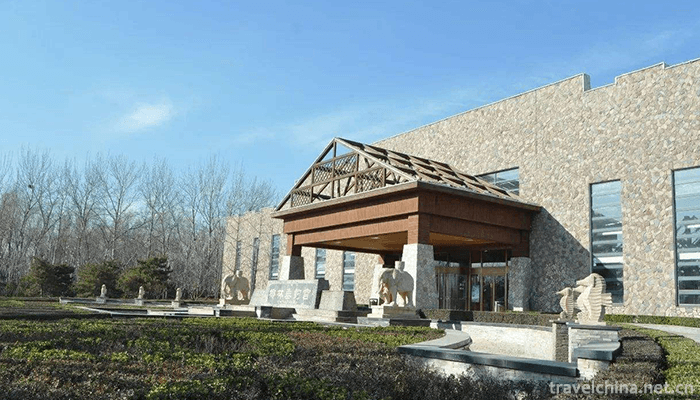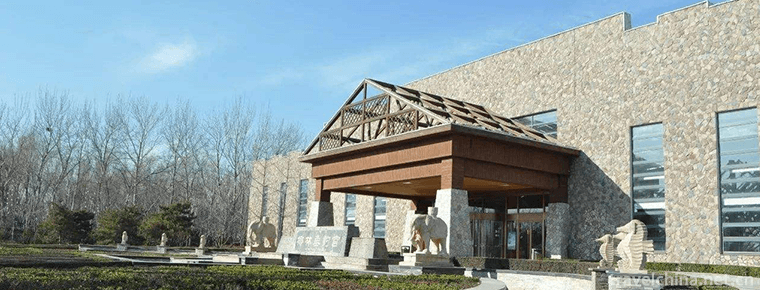Nangong Scenic Spot
Located in Wangzou Town, Fengtai District, southwestern suburb of Beijing, Nangong Village, the village where the scenic spot is located, enjoys the reputation of "China's first geothermal village". It has won eight national honorary titles, including "National Advanced Grass-roots Party Organization", "National Advanced Unit for Spiritual Civilization Creation" and "National Agricultural Tourism Demonstration Site".
Development history
Wang Zuo Town has a long history and profound cultural connotations. In 2006, the town's villages and monuments, history and culture, ancient temples, temples and folk flower fairs were extensively investigated, and many valuable historical data were obtained. In order to promote historical culture, protect cultural relics and monuments, develop cultural industry and integrate tourism resources, Wangzuo Town plans to set up a historical and cultural exhibition room in Wangzuo Town, a district-level cultural relics protection unit in the town area, the Nangong Guandi Temple.
Geographical resources
Relying on high-quality and abundant geothermal resources, the scenic spot integrates modern agricultural sightseeing, hot spring fitness, geothermal popular science education, leisure and recreational vacation. With its excellent air index, beautiful natural environment and good geographical location, it has become one of the ten tourism routes in Beijing. Nangong Tourist Scenic Area, with its magnificent humanistic landscape, beautiful natural landscape, harmonious ecological environment and garden-style tourism city, shows the modern style of the new socialist rural community to the world.
The people of Nangong wholeheartedly welcome all walks of life, party and government organs, enterprises, institutions and school groups to visit and inspect Nangong. Local culture
Culture is the soul of a city. A city without cultural connotations can not become a modern civilized city in the true sense; a city without cultural individuality can not become an admirable city of charm.
Wang Zuo Town is building an "international, garden-style tourism small city". In order to realize ecology, leisure, livability and harmony, it is not enough to develop economically, but also to inherit, disseminate and develop culture. The construction of the historical and cultural exhibition room in Wangzoo Town aims at displaying the colorful cultural relics of Wangzoo Town and striving to reflect the flavor of Wang Zou, culture, folklore and history. To satisfy the cultural aspirations of outsiders and nourish the pride and confidence of the local people. To build the exhibition room, we should not only embody the harmony and unity between man and nature, but also carry forward Wang Zuo's history and culture, integrate tourism resources and play an important role in the development of tourism in the whole town. It will not only become another highlight of Hexi Eco-zone, enrich the industrial chain of tourist areas, enhance regional visibility, but also inherit and carry forward the traditional excellent culture of the Chinese nation.
Tourism information
Ticket information
Tickets are free. There is no first gate ticket in the tourist area. Hot springs, Qianlingshan scenic spot and Qinglong Lake are sold separately.
Traffic information
Driving routes: 1. After turning right at the exit of the 19A Wangzoonang Palace on the Beijing-Hong Kong-Macao Expressway, it will arrive 1.5 kilometers along the road sign. 2. Drive westward along Lianshi Road, up to West Sixth Ring Road and towards Fengtai. See "Shayang Road" at Exit 43, then drive out to Qianlingshan Scenic Spot. See "Changqing Road" at Exit 42, then drive out to Nangong Scenic Spot and Qinglonghu Park.
Passenger routes: 321, 339, 662, 983, 458, 459, 550, 356, 978, 917 Qinglonghu special line
Ruins culture
(1) Culture
Folk flower fairs: National intangible cultural heritage - Weicun Taiping Drum, Beijing intangible cultural heritage - Miliangtun Stilts Club, etc.
Buddhist culture: Qianlingshan Grottoes and Temples, etc.
Taoist culture: Nangong Guandi Temple, etc.
(2) Monuments:
District-level cultural relics protection units: Miyan Pagoda, Qianlingshan, Nangangwa Ancient Bridge (city, District level), Sansheng Temple
Other monuments: Linjiafen Tomb, Zhoujiapo Ancient Military Village, Fomengou Ancient Quarry
(3) Cultural relics:
Regional Cultural Relics Protection: "Five Provisions of Stone Carvings"
Other cultural relics:
Arc back knife coin;
Copper cattle, golden iron pedals, several jade books, copper, iron, pottery, porcelain, stone ware, gold foil flower unearthed from Shi Siming's tomb.
Blue Dragon, Gate Ring and Stone Buddha. Existing in Beijing Liaojin Chengyuan Museum;
Dading copper coin unearthed from Wayao village is 3 square meters, and there are also Yingqing anti-porcelain Guanyin, copper lampstand, copper pot, copper tripod, Yingqing plus color lotus leaf cover pot, chrysanthemum petal body of Longquan kiln.
A celadon pot with a height of 28.4 cm was unearthed from the Ugurun family cemetery in Miliangtun Village.
Unicorn unearthed in Liu Taizhuang;
Qianlingshan Grottoes Temple unearthed a large number of stone Buddhas, ancient construction, stone tablets, Sutra boards and so on.


-
1.Chongqing small noodles
Chongqing small noodles is one of the four characteristics of Chongqing
Time 2018-10-12 -
2.Shaoshan
Shaoshan City, which belongs to Hunan Province, is located in the hilly area of central Hunan Province east of central Hunan Province. Shaoshan is situated in the west of Xiangtan City
Time 2018-12-12 -
3.Sanxingdui Museum
The Sanxingdui Museum was founded in August 1992 and opened in October 1997. It is located in the northeast corner of Sanxingdui Site, a national key cultural relic protection unit.
Time 2018-12-18 -
4.Kunyu Mountain National Forest Park
Kunyushan National Forest Park is located in Mouping District, Yantai City, Shandong Province. It covers an area of 48 square kilometers and belongs to warm temperate monsoon
Time 2019-01-29 -
5.Tibetan drama
The Tibetan name of Tibetan opera is "Aguiram", which means "fairy sisters". According to legend, Tibetan opera was first performed by seven sisters. The content of the opera is mo
Time 2019-04-05 -
6.Kazakh medicine
Since the pre-Qin Dynasty, the Kazakh people have multiplied and lived in the vast grasslands and some agricultural areas in Northwest China. They have accumulated rich medical experience in productio
Time 2019-05-02 -
7.March 3rd Festival of Li Nationality
The third day of March (the third day of the third month of the third lunar month) is the grandest traditional folk festival of the Li people in Hainan Province. It is also a beautiful day for the you
Time 2019-05-12 -
8.Longyan tea lamp
Longyan tea-picking lamp, also known as tea-picking and butterfly-beating, is a popular folk dance and singing in Longyan city and countryside. It integrates rap, opera and dance into a comprehensive
Time 2019-05-14 -
9.Match show
Sai opera is an ancient opera which has been spread in Shanxi, Hebei, Inner Mongolia and Shaanxi. It is a traditional literary form with strong local characteristics of frontier fortress. Sai opera wa
Time 2019-06-12 -
10.Timago of Tujia Nationality
The Tujia Tima song, also known as the "Tujia Tima Goddess Song", is an ancient song sung in Tujia language in the activities of Tujia Tima. It mainly distributes in Longshan, Yongshun, Baoj
Time 2019-06-23 -
11.Guan Yu
Guan Yu(? - 220 years), the word is long, then changed word cloud length. Hedong County Jie county (today) Shanxi Yuncheng People are called "beauty beard Gong". Early follow Liu Bei In the
Time 2019-09-07 -
12.The evolution of Guangyuan
Guangyuan was ruled by Yin state in Xia Dynasty and Ju state in Zhou Dynasty. At that time, the state of Ju was in a state of tripartite confrontation with the states of BA (governing Chongqing) and Shu (governing Chengdu).
Time 2020-12-15